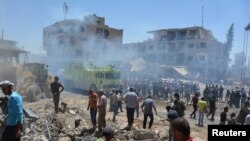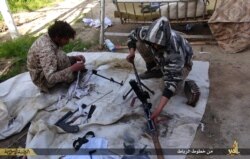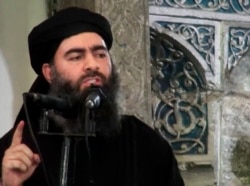Islamic State militants have increased their terror activity in recent weeks in Syria, carrying out deadly attacks against Syrian regime troops and U.S.-backed forces.
Since early December, the terror group has conducted at least three major attacks on Syrian government forces and their allied militias in the eastern province of Deir el-Zour, local sources said.
According to the Syrian Observatory for Human Rights, a war monitor that has reporters across the country, recent attacks claimed by IS against Syrian military forces have killed at least 30 soldiers and wounded more than 50 others.
Last week, at least three fighters with the U.S.-backed Syrian Democratic Forces were killed in what local military officials described as a suicide attack carried out by IS militants in the province of Raqqa, IS's former de facto capital before it was freed in 2017 by the SDF and its U.S.-led allies.
'Threat to our forces'
IS "terrorists still pose a threat to our forces, especially in the eastern part of Syria," an SDF commander told VOA.
"They have been able to regroup and reorganize in some remote parts of Deir el-Zour, where there is a smaller presence of our forces or any other forces," said the commander, who requested anonymity because he wasn't authorized to speak to journalists.
He added that despite the declaration of the physical defeat of the terror group in March 2019, IS "still has hundreds of sleeper cells that have the capability to wage deadly attacks on civilians and combatants alike."
In the town of Tabqa, in western Raqqa, local news reports this week said a suspected IS sleeper cell assaulted a family, killing three of its members, including a child. The reports did not say why the family was attacked, but IS has in the past targeted people whom it suspected of having ties to or working for the government or U.S.-backed local forces.
While most of the recent activity has been in areas IS once controlled as part of its so-called caliphate, the militant group has been particularly active in Syria's vast desert region.
The Syrian Observatory reported at least 10 IS-claimed attacks in December that originated from the mostly desert eastern part of Homs province in central Syria.
Baghdadi's death
Despite the death of its leader, Abu Bakr al-Baghdadi, in October in a U.S. operation in northwestern Syria, IS still represents a major threat in Syria, Iraq and elsewhere, experts say.
"As ISIS returns to its original decentralized structure, members of the group are trying to show ISIS still poses a threat, even after the defeat of its caliphate and the recent death of Abu Bakr al-Baghdadi," said Kaleigh Thomas, a Middle East researcher at the Center for a New American Security in Washington, using another acronym for IS.
Sadradeen Kinno, a Syrian researcher who closely follows Islamist militancy, echoed Thomas' views.
"IS is now living a period of stability, so to speak. After the death of Baghdadi, their objective is clearer now. They try to stay focused on carrying out assassinations, ambushes and suicide attacks, and they have been successful at that," he told VOA.
Kinno said IS "really believes in a recurrent cycle of violence, so for them the territorial defeat they experienced this year is just a phase of their ongoing jihad."
US withdrawal
U.S. President Donald Trump in October announced a withdrawal of troops from Syria, which was followed by a Turkish military offensive against U.S.-backed SDF fighters in northeast Syria.
Some experts say the U.S. troop pullout allowed IS to regroup, and thus its terror attacks have increased.
"The U.S. decision sent a signal to [IS] that the U.S. is not interested in a long-term presence in Syria," said Azad Othman, a Syrian affairs analyst based in Irbil, Iraq.
IS "now feels that its low-level insurgency in Syria could be even more effective as long as the Americans don't have a significant military presence in the country," he told VOA.
The Pentagon's Defense Intelligence Agency said in a report in November that "ISIS has exploited the Turkish incursion and subsequent drawdown of U.S. troops from northeastern Syria to reconstitute its capabilities and resources both within Syria in the short term and globally in the longer term."
"The withdrawal and redeployment of U.S. troops has also affected the fight against ISIS, which remains a threat in the region and globally," Glenn Fine, the principal deputy inspector general, said in the report.
But the U.S. has decided to keep about 500 troops to secure oil fields in Syria to prevent IS militants and the Syrian regime forces from accessing them.
















